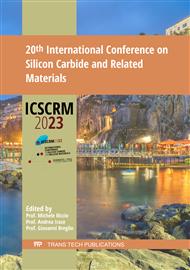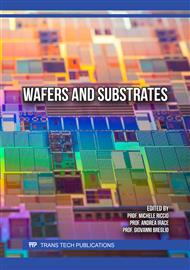p.35
p.43
p.51
p.57
p.67
p.77
p.85
p.91
p.97
Demonstration of SiC-on-Insulator Substrate with Smart Cut™ Technology for Photonic Applications
Abstract:
Silicon-carbide-on-insulator (SiCOI) is a promising platform for photonic integrated circuits. However, the development of this new photonic platform is hindered by the lack of high-quality commercial SiC-on-insulator substrates. In this study, we present a demonstration of the transfer of a single crystalline semi-insulating 4H-SiC thin film on a SiO2 insulated substrate at 150 mm wafer scale using the Smart Cut™ technology. We describe the development of SiCOI substrates and their characterization at each key step of the process. In particular, we provide a detailed study of bow compensation related to the implanted SiC donor substrate. The quality of the transferred SiC layer was investigated as a function of the final annealing temperature applied. The optical indices of the bulk SiC were measured using spectroscopic ellipsometry, and an advanced model has been used to take into account the strong birefringence of the silicon carbide film. Finally, simulations were conducted to design a preliminary set of basic and advanced photonic devices.
Info:
Periodical:
Pages:
67-76
Citation:
Online since:
August 2024
Authors:
Permissions:
Share:
Citation:



